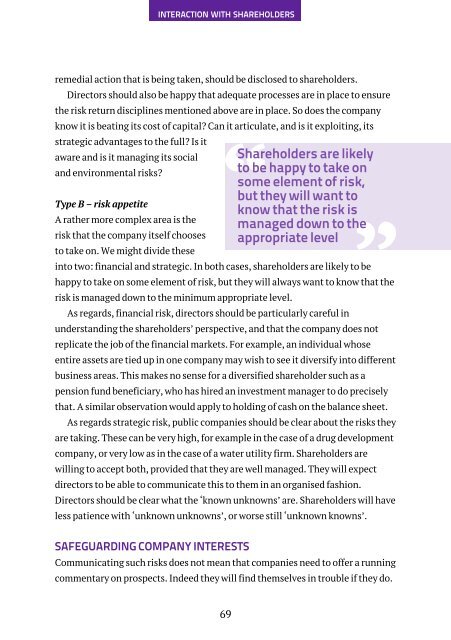Click here to download a pdf - Director Magazine
Click here to download a pdf - Director Magazine
Click here to download a pdf - Director Magazine
You also want an ePaper? Increase the reach of your titles
YUMPU automatically turns print PDFs into web optimized ePapers that Google loves.
INTERACTION WITH SHAREHOLDERSremedial action that is being taken, should be disclosed <strong>to</strong> shareholders.Direc<strong>to</strong>rs should also be happy that adequate processes are in place <strong>to</strong> ensurethe risk return disciplines mentioned above are in place. So does the companyknow it is beating its cost of capital? Can it articulate, and is it exploiting, itsstrategic advantages <strong>to</strong> the full? Is itaware and is it managing its socialand environmental risks?Shareholders are likely<strong>to</strong> be happy <strong>to</strong> take onsome element of risk,but they will want <strong>to</strong>know that the risk ismanaged down <strong>to</strong> theappropriate levelType B – risk appetiteA rather more complex area is therisk that the company itself chooses<strong>to</strong> take on. We might divide thesein<strong>to</strong> two: financial and strategic. In both cases, shareholders are likely <strong>to</strong> behappy <strong>to</strong> take on some element of risk, but they will always want <strong>to</strong> know that therisk is managed down <strong>to</strong> the minimum appropriate level.As regards, financial risk, direc<strong>to</strong>rs should be particularly careful inunderstanding the shareholders’ perspective, and that the company does notreplicate the job of the financial markets. For example, an individual whoseentire assets are tied up in one company may wish <strong>to</strong> see it diversify in<strong>to</strong> differentbusiness areas. This makes no sense for a diversified shareholder such as apension fund beneficiary, who has hired an investment manager <strong>to</strong> do preciselythat. A similar observation would apply <strong>to</strong> holding of cash on the balance sheet.As regards strategic risk, public companies should be clear about the risks theyare taking. These can be very high, for example in the case of a drug developmentcompany, or very low as in the case of a water utility firm. Shareholders arewilling <strong>to</strong> accept both, provided that they are well managed. They will expectdirec<strong>to</strong>rs <strong>to</strong> be able <strong>to</strong> communicate this <strong>to</strong> them in an organised fashion.Direc<strong>to</strong>rs should be clear what the ‘known unknowns’ are. Shareholders will haveless patience with ‘unknown unknowns’, or worse still ‘unknown knowns’.SAFEGUARDING COMPANY INTERESTSCommunicating such risks does not mean that companies need <strong>to</strong> offer a runningcommentary on prospects. Indeed they will find themselves in trouble if they do.69









